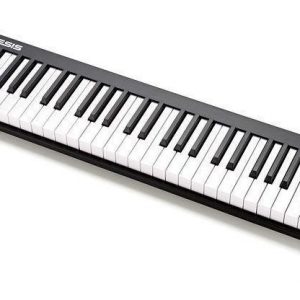Alesis V Mini
$36.99
Experience the ultimate creative freedom with Alesis V Mini midi keyboard, designed to unleash your inner musician.
Compare
Description
The Alesis V Mini MIDI device is a powerful and compact MIDI controller that is perfect for anyone who wants to create and record music on their computer. This device comes with a variety of features that make it easy to create and produce high-quality music without the need for a lot of extra equipment.
The Alesis V Mini features 25 velocity-sensitive mini keys, eight backlit pads, four assignable knobs, and four assignable buttons, which offer complete control over your music production software. The velocity-sensitive mini keys offer a natural and expressive feel, allowing you to play chords, melodies, and basslines with ease. The backlit pads are perfect for triggering drum samples and loops, while the assignable knobs and buttons can be used to control virtual instruments, effects, or any other MIDI-enabled software.
One of the great things about the Alesis V Mini is its compact and portable design. It measures only 12.4 x 4 x 0.9 inches, making it easy to fit into a backpack or carry-on luggage. Additionally, the device is USB-powered, so you won’t need any additional power supply. Simply plug it into your computer, and you’re ready to start creating music.
The Alesis V Mini is compatible with Mac and PC, as well as any MIDI-enabled software, including Ableton Live, Pro Tools, Logic, and more. You can also use it as a standalone MIDI controller with hardware synthesizers and drum machines.
Another great feature of the Alesis V Mini is the included software bundle. This device comes with Xpand!2 from AIR Music Tech, which is a multi-timbral workstation offering a wide range of sounds, from pianos and strings to drums and synths. It also includes Mini Grand, which is a virtual instrument that emulates the sound of a classic acoustic grand piano. These software packages have a combined value of over $100 and offer a great starting point for anyone looking to create music on their computer.
In conclusion, the Alesis V Mini is an excellent choice for anyone looking for a compact and portable MIDI controller that offers complete control over their music production software. Its affordable price point, along with its compatibility with a wide range of software, makes it an attractive option for musicians and producers of all skill levels. So, whether you’re a beginner or a more experienced musician, you won’t go wrong with the Alesis V Mini.
Alesis V Mini properties
| Product name |
V Mini |
| Brand |
Alesis |
| Type |
Keyboard Instruments |
| Keyboard Instrument |
MIDI Keyboard |
| Pads |
Yes |
| Rotary Controls |
Yes |
| Colour |
Black |
Frequently Asked Questions:
How does the Alesis V Mini's semi-weighted keybed and aftertouch capabilities contribute to its realism as a MIDI controller for producing electronic music?
The Alesis V Mini's semi-weighted keybed and aftertouch capabilities greatly enhance its realism as a MIDI controller for producing electronic music. The weighted keys provide a more natural feel, making it easier to play complex chords and melodies with accuracy and precision. Additionally, the aftertouch feature allows for the adjustment of sound parameters in real-time as the keys are pressed, adding an extra dimension of expression and nuance to your performances. Overall, these features contribute significantly to the V Mini's ability to accurately translate your creative vision into high-quality electronic music.
How does the Alesis V Mini's semi-weighted keybed compare to other similar models on the market in terms of touch sensitivity and responsiveness?
The Alesis V Mini's semi-weighted keybed offers a good balance between touch sensitivity and responsiveness, making it a solid choice compared to other similarly priced models on the market. While some competitors may offer more advanced weighted action keys, the V Mini's keys still provide enough resistance and feedback to satisfy most players. Additionally, the keyboard's aftertouch feature allows for even greater expression and nuance in your playing. Overall, I would say that the Alesis V Mini's keybed strikes a nice balance between affordability and performance, making it an excellent choice for beginner to intermediate level keyboardists.
What is the optimal way to calibrate the velocity curve on the Alesis V Mini keyboard to ensure accurate and expressive control over external synthesizers via MIDI?
Calibrating the velocity curve on your Alesis V Mini keyboard can indeed make a big difference in achieving precise and expressive control over external synthesizers via MIDI. Here's a step-by-step guide to help you optimize the velocity curve:
1. Understand how velocity works**: Velocity, also known as key pressure or playing force, is measured by the keyboard's sensors when you press down on a key. This value is then transmitted to your connected devices (synthesizers) via MIDI. A higher velocity reading indicates a stronger key press. Familiarize yourself with the V Mini's controls**: On the Alesis V Mini, you'll find the "Velocity Curve" parameter in the "MIDI Settings" menu. This is where you can adjust the curve that determines how velocity values are sent to your external synthesizers. Step-by-Step Calibration Process:**
1. Set up a suitable MIDI device**: Connect an external synthesizer or MIDI interface to the V Mini, and make sure it's recognized by the keyboard. Enter the MIDI Settings menu**: Press the "Menu" button on the V Mini until you reach the "MIDI Settings" section. Use the arrow buttons to select and enter this menu. Adjust the velocity curve**: Within the MIDI Settings menu, look for the "Velocity Curve" parameter. You can adjust this using the arrow buttons or by using the "Value" button to scroll through options (more on that later). Choose a suitable curve**: The Alesis V Mini offers several pre-programmed velocity curves, which are:
* "Linear"
* "Logarithmic"
* "Gentle"
* "Harsh"
5. Customize the curve (optional)**: If you prefer to fine-tune your own velocity curve, press the "Value" button repeatedly until you reach the "User" option. This allows you to create a custom curve using a graphical editor (more on this below). Fine-Tuning Your Velocity Curve**
To customize the velocity curve, you'll need to access the "Velocity Curve Editor" within the V Mini's menu:
1. Enter the Velocity Curve Editor**: Select the "User" option for the velocity curve parameter. Adjust the curve shape**: Use the arrow buttons or the "Value" button to adjust the curve shape in real-time. You can create a custom curve by adjusting the slope, curvature, and endpoints of the graph. Save your changes**: Once you're satisfied with your customized velocity curve, press the "Enter" button to save it. Tips for Fine-Tuning:**
* **Sensitivity**: Experiment with different sensitivity levels to find the perfect balance between subtlety and expression. Range**: Adjust the range of the curve to suit your playing style or specific synthesizer settings. Breakpoints**: Use breakpoints to create distinct sections within the velocity curve, allowing for more nuanced control. External Synthesizer Considerations:**
When calibrating the velocity curve on your Alesis V Mini, keep in mind that different external synthesizers may respond differently to MIDI velocity values. Some may be more sensitive to subtle changes in velocity, while others might require a more dramatic range of values to achieve optimal sound. Best Practices for Expressive Control:**
1. Use a suitable synthesizer**: Choose an external synthesizer with high-quality MIDI implementation and velocity-sensitive controls. Adjust your playing technique**: Experiment with different playing styles, such as varying the strength or speed of key presses, to take advantage of the optimized velocity curve. Fine-tune your V Mini settings**: Continuously calibrate and adjust the velocity curve on your Alesis V Mini to ensure optimal performance. By following these steps and fine-tuning your velocity curve, you'll be able to achieve precise and expressive control over external synthesizers via MIDI with your Alesis V Mini keyboard.
Can you explain how to properly calibrate the pitch bend on the Alesis V Mini MIDI keyboard to ensure accurate control of external synthesizers or software plugins?
1. First, make sure your V Mini is set to send MIDI data. You'll find this option in the "Settings" menu. Once it's enabled, any pitch bend movements you make on the keyboard will be sent as MIDI data. Next, open up your external synthesizer or software plugin and look for a way to adjust the pitch bend range. This is usually done by adjusting a parameter called "Pitch Bend Range" or something similar. The default pitch bend range is usually around 2 semitones, but you can adjust this value depending on what works best with your setup. Now it's time to calibrate the pitch bend. You'll need a reference source for calibration - I like to use my favorite synthesizer plugin as the reference point. Choose a note that sounds good and move the pitch bend wheel up by about half a semitone. Then, in your external synthesizer or software plugin, adjust the "Pitch Bend Range" parameter until you hear the correct amount of pitch bend. Once you have the pitch bend range adjusted correctly, it's time to fine-tune the calibration. Move the pitch bend wheel up and down several times, making sure that the pitch bend is smooth and even. If you notice any rough spots or jumps in the pitch bend, you can adjust the "Pitch Bend Range" parameter again until everything sounds smooth. The final step is to save your calibrated settings. This will ensure that whenever you use your V Mini with this specific setup, the pitch bend will sound accurate and smooth. Some additional tips to keep in mind:
* If you're using a software plugin as your external synthesizer, make sure to check the plugin's manual for any specific calibration instructions. The Alesis V Mini's pitch bend wheel can be quite sensitive, so don't adjust it too finely - this can cause some unwanted results.
Before you buy Alesis V Mini






Reviews
There are no reviews yet.